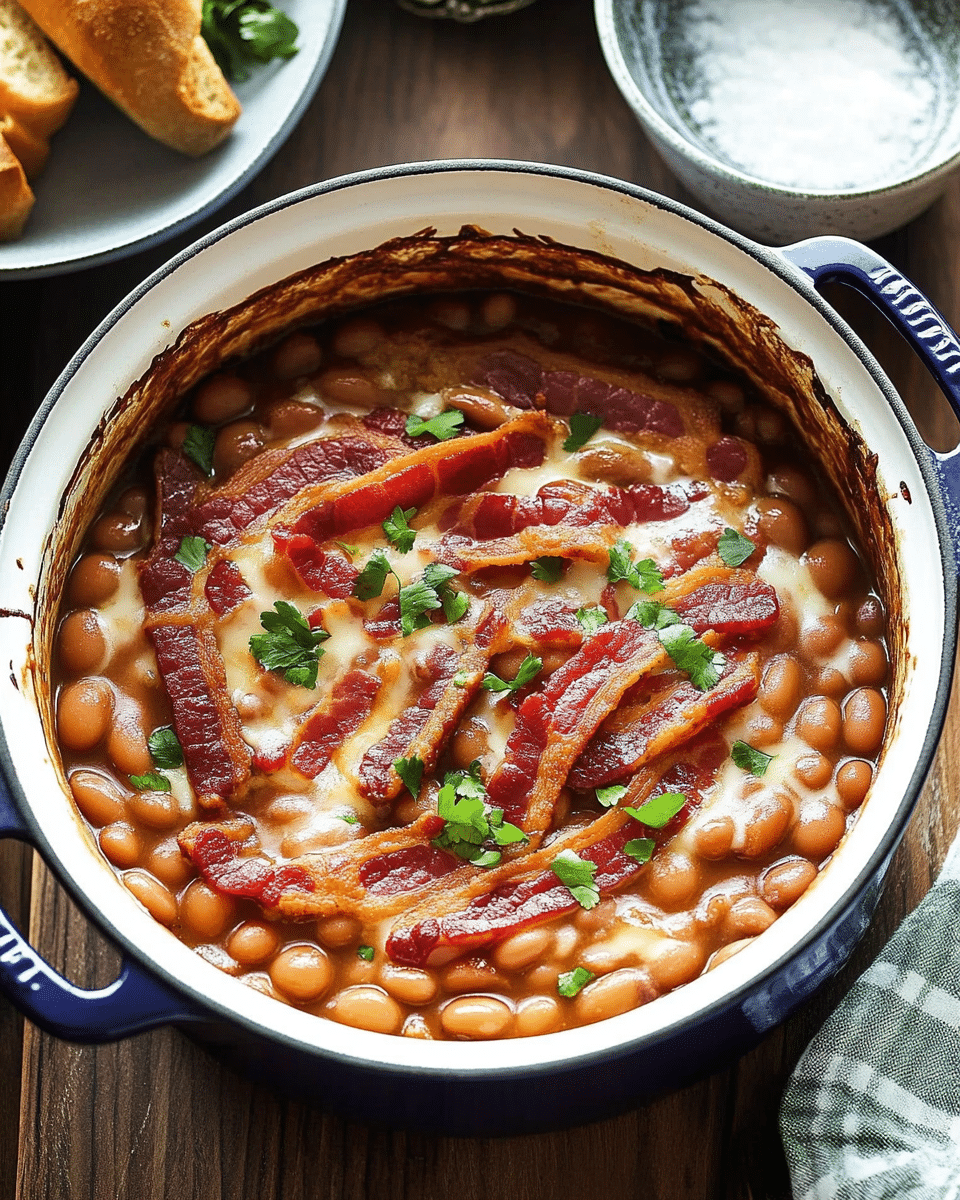Nothing says comfort food quite like a hearty bowl of New England Baked Beans. This classic dish is rooted in colonial American cuisine and remains a staple in households throughout the Northeast. Slow-cooked to perfection, the navy beans absorb layers of flavor from molasses, mustard, brown sugar, and smoky bacon, resulting in a dish that’s sweet, savory, and deeply satisfying. The addition of ground cloves adds a subtle aromatic complexity that elevates the entire profile of the dish.
These baked beans are ideal for family gatherings, backyard barbecues, or a cozy Sunday supper. Their richness makes them a standout side dish, but they can also hold their own as a main course, especially when served with buttered brown bread, grilled sausages, or roasted vegetables. Whether you’re reviving nostalgic flavors from childhood or introducing a new generation to the tradition, this recipe offers old-school comfort with every bite.
Full Recipe:
Ingredients:
-
1 pound dried navy beans
-
8 cups water (for soaking and boiling)
-
1/2 pound thick-cut bacon, chopped
-
1 medium yellow onion, finely chopped
-
1/2 cup molasses
-
1/4 cup brown sugar (light or dark)
-
1 tablespoon Dijon mustard
-
2 teaspoons salt
-
1/2 teaspoon ground black pepper
-
1/4 teaspoon ground cloves (optional)
-
2 cups water (for baking)
Directions:
-
Rinse the dried navy beans thoroughly and soak them overnight in 8 cups of water.
-
Drain the soaked beans and place them in a large pot. Cover with fresh water and bring to a boil. Simmer for about 1 hour, or until the beans are tender but not mushy. Drain.
-
Preheat the oven to 300°F (150°C).
-
In a Dutch oven or large ovenproof pot, layer half of the beans, then half of the bacon, and half of the chopped onion. Repeat the layers.
-
In a separate bowl, whisk together molasses, brown sugar, mustard, salt, pepper, and cloves. Pour this mixture over the beans.
-
Add 2 cups of water, or enough to just cover the beans.
-
Cover and bake for 2 hours. Then uncover and bake for another 1 to 1.5 hours, checking occasionally and adding water if beans look too dry.
-
Remove from oven when beans are thick and tender with a rich, sticky coating.
-
Allow to rest 10-15 minutes before serving for flavors to settle.
Prep Time: 20 minutes | Cooking Time: 3.5 hours | Total Time: 3 hours 50 minutes
Kcal: 285 kcal | Servings: 8 servings
New England Baked Beans: A Sweet, Smoky, and Historic Comfort Food
New England Baked Beans are much more than a warm, cozy dish, they’re a rich part of America’s culinary heritage. With roots tracing back to colonial times, this hearty meal is a testament to the enduring power of traditional flavors and slow cooking. Typically made with navy beans, sweet molasses, savory mustard, and smoky bacon, these beans have long been a staple on New England tables, particularly in Massachusetts where the city of Boston earned the nickname “Beantown.” Whether you’re serving them alongside barbecue meats or enjoying them on their own, these beans are sure to bring a sense of nostalgia and wholesome satisfaction to any meal.
In today’s fast-paced world, slow-cooked dishes like these stand out not just for their robust flavor, but also for their simplicity and soulfulness. The beauty of New England Baked Beans lies in their ability to transform a few humble ingredients into a dish bursting with complex flavors. Molasses adds depth and sweetness; bacon brings in a rich, smoky dimension; and mustard, onions, and spices round everything out with a bit of tang and spice. All of these elements come together during the long baking process, which allows the beans to absorb every nuance of flavor while becoming irresistibly tender.
A Brief History of Baked Beans in New England
The origin of baked beans in New England is deeply rooted in history, dating back to Native American cooking traditions. Indigenous tribes in the northeastern region prepared a dish using beans, maple syrup, and bear fat, an early ancestor to today’s molasses and bacon-based baked beans. When the Puritans arrived, they adapted the recipe by incorporating ingredients from their pantries, including salt pork or bacon and molasses, which was abundant due to the area’s role in the sugar trade.
The dish became so integral to the culture that it was often served on Saturdays to prepare for the Sabbath. Since cooking wasn’t allowed on Sundays due to religious restrictions, families would prepare the beans on Saturday, letting them slowly cook overnight in brick ovens. This resulted in a hot, ready-to-eat dish on Sunday without violating Sabbath rules.
Today, the tradition lives on, not necessarily because of religious customs, but because of the comfort and flavor that New England Baked Beans deliver with each spoonful.
Why Navy Beans?
Navy beans are the classic choice for this recipe for several good reasons. First, they hold their shape well during long cooking times, making them ideal for slow-cooked dishes. Second, their mild flavor allows them to soak up the sweet, tangy, and smoky notes of the sauce. And third, they’re affordable, nutritious, and widely available.
That said, other beans can be substituted in a pinch. Great Northern beans, pinto beans, or even cannellini beans can work, although they might slightly alter the texture or flavor. If you’re a stickler for authenticity, stick to navy beans, but feel free to experiment if you’re looking for variety.
The Role of Molasses
Molasses is the heart of the flavor in New England Baked Beans. It adds a rich, slightly bittersweet depth that complements the saltiness of the bacon and the acidity of the mustard. Historically, molasses became a key ingredient because of its availability in the region during the Colonial era. Boston, being a hub in the triangular trade, had an abundance of molasses, which became a favored sweetener before refined sugar was widespread.
When choosing molasses for your recipe, avoid blackstrap molasses unless you enjoy a very bold and slightly bitter taste. Regular unsulphured molasses is ideal, offering a pleasant sweetness without overpowering the dish.
Making It Your Own
One of the best things about New England Baked Beans is how adaptable they are. While the classic version calls for bacon, those following a vegetarian or vegan diet can simply skip the meat or replace it with smoked paprika, liquid smoke, or even tempeh for a plant-based twist. Want to spice it up? Add a dash of cayenne or smoked chipotle powder. Prefer them even sweeter? Increase the brown sugar slightly or add a bit of maple syrup.
You can also cook the beans in different types of vessels. While a traditional ceramic bean pot is ideal and historically accurate, a Dutch oven or a heavy-duty casserole dish will work just as well. Just make sure it has a lid to help retain moisture during baking.
Some cooks even prepare their baked beans in a slow cooker or pressure cooker to save time. While these methods are convenient, you may lose some of the rich, caramelized edges that develop during oven baking. If using a slow cooker, consider finishing the beans uncovered in the oven for the last 30 minutes to enhance flavor and texture.
What to Serve with New England Baked Beans
These beans are incredibly versatile and can be served in many ways:
-
As a Side Dish: Perfect with grilled meats like ribs, burgers, or hot dogs. They’re also a classic partner for baked ham.
-
On Toast: A hearty, savory breakfast or brunch option. Add a fried egg on top for a delicious twist.
-
With Brown Bread: Traditional Boston brown bread, often steamed and made with molasses and rye flour, pairs beautifully with baked beans.
-
With Coleslaw: The cool crunch of a vinegar-based coleslaw contrasts perfectly with the warm, sticky beans.
-
As a Main Course: Add a salad and some cornbread, and you’ve got a complete and satisfying meal.
Nutritional Benefits
Despite being an old-fashioned comfort food, New England Baked Beans can be surprisingly nutritious, especially when you make them from scratch and control the sugar content.
-
High in Fiber: Beans are a great source of dietary fiber, which supports digestion and keeps you feeling full longer.
-
Protein-Rich: Navy beans offer plant-based protein, and bacon adds additional (albeit fattier) protein content.
-
Packed with Micronutrients: These beans are a good source of iron, magnesium, potassium, and folate.
-
Customizable for Special Diets: You can make them gluten-free, dairy-free, and even vegan with simple swaps.
While the dish is slightly high in sugar due to the molasses and brown sugar, you can always reduce the sweetness without compromising too much on flavor.
Tips for Success
Here are a few expert tips to ensure perfect results every time:
-
Soak the Beans Properly: Overnight soaking helps reduce cooking time and improves texture.
-
Don’t Overcook During Boiling: Stop boiling when beans are just tender. Overcooked beans can become mushy during baking.
-
Layer the Ingredients: Don’t just dump everything in, layering helps the flavors distribute evenly.
-
Keep it Moist: Check the beans during baking and add water as needed. You want a thick sauce, not dried-out beans.
-
Let Them Rest: Letting the beans sit for 10–15 minutes after baking helps the flavors come together and the sauce thicken.
Conclusion
New England Baked Beans are a celebration of flavor, history, and the joys of slow cooking. Rooted in colonial traditions and beloved for generations, they offer a warm, comforting experience that’s hard to beat. Whether you’re serving them at a summer barbecue, during the holidays, or as part of a weekend family dinner, these beans bring a taste of tradition to your table with every bite.
Making them from scratch may take a bit of time, but the rewards are well worth it. The balance of sweet, savory, and smoky flavors is deeply satisfying and endlessly comforting. And with a few tweaks, you can make the recipe your own while staying true to its rich New England roots.
So go ahead, gather your ingredients, preheat your oven, and get ready to enjoy one of America’s most beloved and time-tested dishes.






